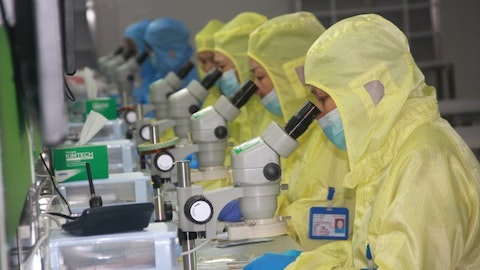Jared Gollob: Yes, Mark. Yes, we really can’t comment on the sort of results beyond what is in the abstract. And as you noted, we’ve enrolled 21 patients so far to the first five dose levels. We noted that 12 patients were valuable across the first four dose levels, and we talked about the one PR and the CTCL patient at those level two, and three cell of tumor patients who are stable at those level three and level four. So, our plan in December at ASH is to, obviously, provide updates both on those patients, as well on any additional patients who have enrolled onto the trial between that abstract cutoff date and the cutoff date for the ASH poster.
Nello Mainolfi : Maybe if I won’t get in trouble with ASH here, I just want to add maybe a couple of more things. So, one, I guess, the ones that were not evaluable. I would guess, I don’t know the details, it’s a mix of patients that progressed too early and patients that are still early in their dosing in the — more recent cohorts. And I think it’s fair to say that for the ASH abstract, we do expect sort of — actually the ASH presentation, we do expect to see evaluation of more liquid tumor patients. We can’t say how many, but we expect to see more than the first two on those level two.
Marc Frahm : Okay. That’s helpful. And then as you laid out earlier in response to one of the other questions, the bigger hypothesis here really is combination for solid tumors. I guess, can you lay out what do you need to show in this trial in order to kind of trigger those combi — opening up those combination cohorts?
Nello Mainolfi : Yes. Before we go there, I want to make sure — I don’t want to sound overly positive, but I also want to sound realistic. We have shown for the first time that STAT3 degradation can help patients. This has never been done before this way. And so, I think we need to just take a moment and appreciate that this is first-in-class data. And while we can debate, obviously, the size of the patient population that the single agent activity is pursuing, we should not forget that that’s what we’re here to do, we’re helping patients with innovative first-in-class medicines. So, I’m not deflecting your question. So now going to your question, there are several things that we want to be able to see to move into an expansion cohort in a solid — in solid tumors.
First, understand the degradation safety and any signs of — any activity that we see as a single agent in solid tumors. As you know, we don’t expect to see single-agent activity. We have some stable diseases. They are actually have been, for quite a while, we can’t — it’s hard for us to know how much of that is, the disease being slow progressive or how much of that is the actual degradation of STAT3. We’d like to think that it’s probably a bit of both. But — so there is an aspect of that. There is an aspect of, as I mentioned earlier, looking at tumor biopsies and understand if we can replicate what has been shown actually, both preclinical in the clinic with other agents, including STAT3-dep in terms of modulating the tumor microenvironment.
And then as I mentioned, we have ongoing activities preclinically, not only actually exploring the STAT3 PD-1 combo, but also STAT3 and other targeted therapies combos. And I think where we stand today, we have optimism that this mechanism is a place in drug development in oncology. It’s just for us too early to say what that is until we complete all these series of studies, as I said, both clinical and preclinical.
Operator: Next question would be from Eliana Merle, UBS. Please go ahead.
Unidentified Analyst: This is Jasmine on for Eli. Thanks for taking my question. On STAT3, how are you thinking about kind of the dose response and the optimal levels of degradation? Do you think that the optimal dose could be different in solid tumors versus the hematological phase? And then I have a follow-up on 333.
Nello Mainolfi : Jared, do you want to take that one?
Jared Gollob: Yes, it certainly is possible that there could be different recommended Phase II doses for solid tumors lymphomas, which is the Arm A of the Phase Ia versus high-grade myeloid malignancies, including AML, which is Arm B. We think, ultimately, activity is going to be probably a function of MDM2 degradation and the level of p53 pathway activation that we’re able to elicit either in solid tumors lymphomas or in AML, along with the sensitivity of those tumor types to p53 mediated apoptosis. Also, of course, it’s going to be the safety profile of the drug, which may be the same in liquid and solid tumors or could be different. So, these are all the things that we’ll be investigating in these two Arms on study. Looking at safety, looking at the degree of p53 pathway, engagement and activation that we’re able to elicit with the drug, and of course, then looking at clinical activity.
And that will determine what will be either the maximum tolerated dose or the recommended Phase II dose that we bring into the next phase of development, which will be Phase Ib. And again, as you sort of noted, it’s possible that it may be made up having the same dose used across all those indications or there could be different doses across solid tumor lymphomas versus liquid tumors. But the study is designed to allow us to assess that and make the determination by the end of Phase Ia.
Nello Mainolfi : And just to add, I know we have got other questions, but I just want to highlight, just as I did for 333. I mean the CTCL for 253 was and continues to be with a degrader mechanism. You can drive tumor cells to a quick apoptotic response and have infrequent dosing regimen that maximizes efficacy and safety. And while we have limited data, and I will say that again, limited data, it was extremely exciting for us to see that the thesis is playing out in the way that we imagine or probably even better at this point. So, I would encourage everybody to keep an eye on this program because if the profile continues to evolve this way, I think we’ll have a really large opportunity set in evolving patient certification thesis that we’ll share more of next year.
Unidentified Analyst: Awesome. And then just quickly on 333. Those three stable diseases that you saw in solid tumor patients, can you give any color on what tumor types those were?
Jared Gollob: We actually saw the stable disease across a variety of different solid tumor types. And as Nello mentioned, we have some patients who have had fairly prolonged stable disease as well. I think we’ll be able to provide, I think, more color on the actual solid tumor types at the actual ASH presentation in December. But I think it’s very encouraging that on the study, we’ve been able to enroll a variety of different solid tumor types as well as a variety of different T-cell malignancy types, including PTCL, CTCL, and others as well. So, I think we’ll look forward to providing more of those details and updates in December at the ASH presentation.
Operator: Next question will be from Eric Joseph, JPMorgan. Please go ahead.
Eric Joseph : Hi, good morning. Just might be asking you to step a little bit into the January R&D Day, but can you talk about how your experience with KT-333 so far informs the attractiveness of STAT3 within your oral immunology pipeline planning relative to other targets of interest? And does your experience with 333 perhaps give you a head start on an oral degrader versus some of the other targets? Does it inform — yes, I guess total what are the lessons so far from the IV formulation that can carry over to oral? Thank you.
Nello Mainolfi : Yes, Eric. Great question. So not to not answer your question, but I would point to two things. First, I think what we learned the most about oral degraders in immunology is from the KT-474 program. As you know, we took a bold approach a few years ago to take targeted protein degradation in immunology. And I think we’ve been rewarded by that approach. We’ve shown how a oral degrader can be safe, can be well tolerated, can be effective at degrading the protein, can have a really substantial anti-inflammatory effect as measured by cytokine inhibition, and also has shown early signs of clinical activity. As you know, we’ve been careful with overweighing on the clinical activity because of the small lands. But I think it’s clear to say that if you look at the totality of the data, there was clearly benefiting patients.



